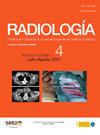基于RM的4D流程临床应用
IF 1.1
Q3 RADIOLOGY, NUCLEAR MEDICINE & MEDICAL IMAGING
引用次数: 0
摘要
四维流动磁共振成像(MRI)是一种时间分辨的三维相衬技术。它通过在整个心脏周期的三个空间维度上绘制血流速度图,为心血管系统提供容积信息。在过去的二十年里,MRI技术的进步促进了它从实验环境到临床实践的转变,从而使人体各种血管区域的血液动力学的无创体内评估成为可能。本文试图阐明其起源和基本技术原理,描述其主要临床适应症-特别是在心胸领域-并回顾其局限性和未来发展方向。这种诊断模式的不断发展使人们进一步了解异常血流动力学和心血管疾病之间的相互作用,有望提高临床价值。本文章由计算机程序翻译,如有差异,请以英文原文为准。

Aplicaciones clínicas del flujo 4D por RM
Four-dimensional flow magnetic resonance imaging (MRI) is a time-resolved three-dimensional phase-contrast technique. It provides volumetric information for the cardiovascular system of interest through blood flow velocity mapping in three spatial dimensions throughout the cardiac cycle. The technological advances of MRI over the last two decades have facilitated its transition from the experimental environment into clinical practice, thereby enabling the non-invasive in vivo assessment of haemodynamics across various vascular territories of the human body. This article endeavours to elucidate its inception and fundamental technical principles, to delineate its main clinical indications—particularly in the cardiothoracic domain—, and to review its limitations and future directions. The ongoing evolution of this diagnostic modality continues to develop further understanding of the interplay between abnormal haemodynamics and cardiovascular pathologies, promising enhanced clinical value.
求助全文
通过发布文献求助,成功后即可免费获取论文全文。
去求助
来源期刊

RADIOLOGIA
RADIOLOGY, NUCLEAR MEDICINE & MEDICAL IMAGING-
CiteScore
1.60
自引率
7.70%
发文量
105
审稿时长
52 days
期刊介绍:
La mejor revista para conocer de primera mano los originales más relevantes en la especialidad y las revisiones, casos y notas clínicas de mayor interés profesional. Además es la Publicación Oficial de la Sociedad Española de Radiología Médica.
 求助内容:
求助内容: 应助结果提醒方式:
应助结果提醒方式:


